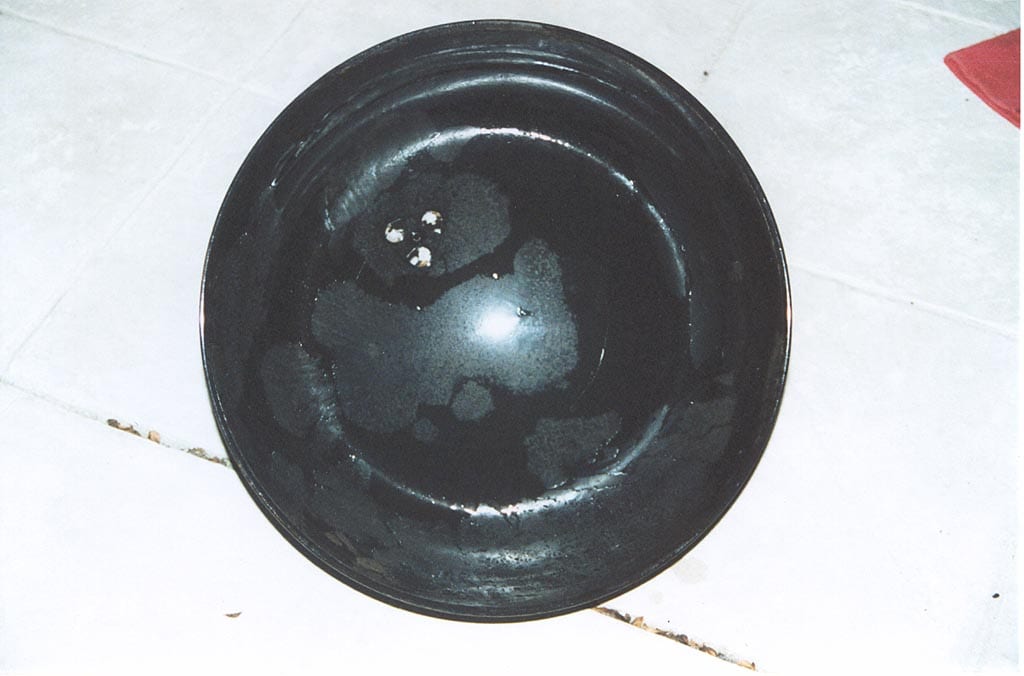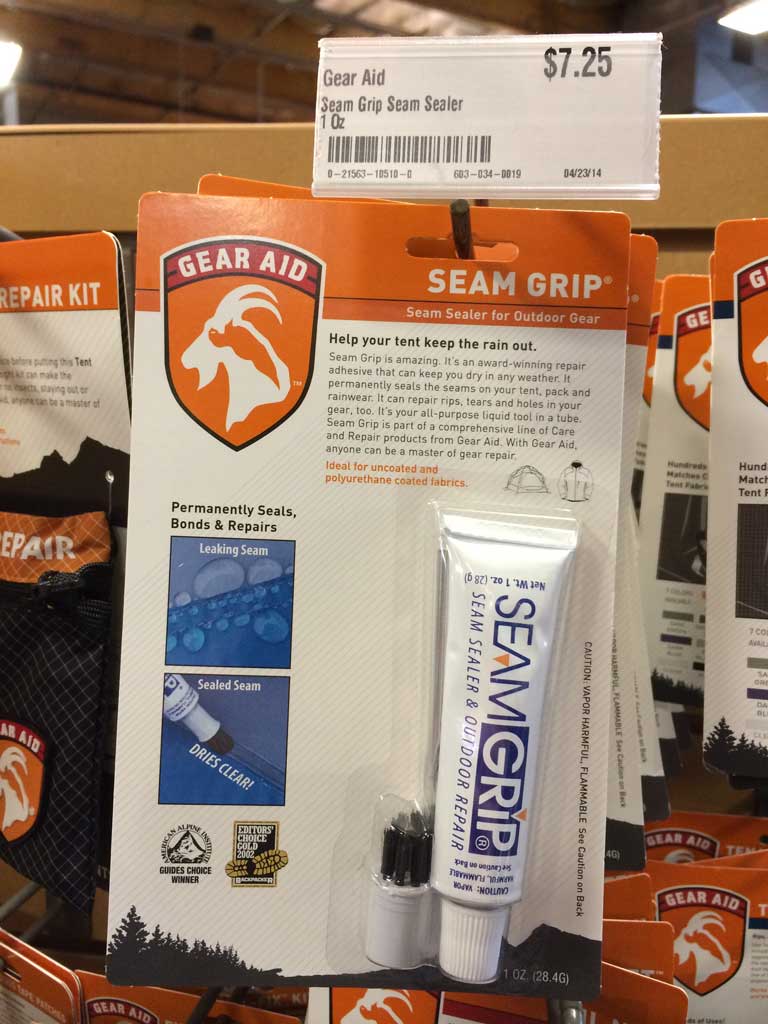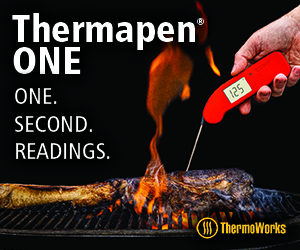General Questions
- Where can the Weber Smokey Mountain Cooker Smoker be purchased?
- How much does the WSM cost?
- How is the WSM constructed?
- I heard a rumor that the WSM middle cooking section is painted, not porcelain coated. Is that true?
- Where is the WSM manufactured?
- What are the dimensions and weight of the WSM?
- How large are the cooking grates?
- How long is the warranty, and what’s covered?
Cooker Operation
- Does a new WSM need to be seasoned before use?
- What are the best methods for firing up the WSM?
- Can the WSM be fired using wood chunks or logs instead of charcoal?
- How much smoke wood should be used in the WSM?
- Does using a flavorful liquid instead of water in the water pan make a difference?
- Are there hot spots in the WSM? Meat towards the edge of the cooking grate tends to overcook or burn.
- Why do I sometimes get ashes on my meat?
- Does wind affect the performance of the WSM?
- Does rain affect the performance of the WSM?
- Does the WSM need to be insulated during use in the winter?
- How can the cooking capacity of the WSM be increased?
- Can handles be mounted on the cooking section so it and the lid can be removed together during cooking?
- Can the WSM be converted to electric or gas?
- Can the WSM be used as a charcoal grill?
Measuring & Controlling Temperature
- Does the WSM run hot when brand new?
- What are the options for measuring temperature in the WSM?
- What is a probe thermometer and how is one inserted into the WSM?
- The WSM runs too hot. Even with all the bottom vents closed, the temperature won’t go below 250°F.
- I can’t extinguish the fire in the WSM. Even with the top vent and all the bottom vents closed, the fire won’t go out.
- The WSM runs too cool. Even with all the bottom vents open and a full charcoal chamber, the temperature won’t go over 200°F.
- What is the difference in temperature measured through the lid versus at each cooking grate?
Troubleshooting
- What is that rust-colored residue inside the lid? Is the metal rusting?
- What is that black material peeling off inside the cooker? Is the finish coming off?
- What is that black, oily substance dripping from the bottom vents of the charcoal bowl or seeping out around the access door knob?
- How can I protect my deck or patio from that black, oily substance that drips off the cooker?
- How can I protect my wooden deck from the heat radiating from the charcoal bowl?
- Why does the lid sometimes stick to the middle cooking section?
- Is it normal for smoke to escape from around the lid and access door?
- Why does water collect in the bottom of the cooker, even when the vinyl cover is in place? Why doesn’t the lid overlap the middle cooking section like other Weber grills?
- How do I loosen a tight vent damper on a new WSM?
- How do I loosen a sticky vent damper?
- How do I tighten a loose vent damper?
- How do I fix a bent vent damper?
Cleanup & Maintenance
- Can hot coals be extinguished by dousing them with water?
- Can I dispose of charcoal ashes in the garden?
- Any tips for cleaning the cooking grates?
- Any tips for cleaning the water pan?
- When rust develops on the cooking grates, at what point should they be replaced?
- Can the bottom of the charcoal bowl be lined with foil for easy cleanup?
- How can I remove ashes that have solidified like concrete in the bottom of the charcoal bowl?
- How do I clean mold or mouse droppings inside my cooker?
- How can the wooden lid handle be protected during rain?
Security
Trivia
- What is the meaning of the letters and numbers stamped into each vent damper?
- How can I determine the age of a WSM?
- Why is there a small hole in the edge of the water pan?
General Questions
Q: Where can the Weber Smokey Mountain Cooker Smoker be purchased?
A: Amazon.com makes buying the Weber Smokey Mountain Cooker fast and easy!.
- 14.5″ WSM pricing and availability
- 18.5″ WSM pricing and availability
- 22.5″ WSM pricing and availability
The WSM is also available from other online retailers and at some national hardware chain stores, home centers, regional barbecue chain stores, and high-end pool and patio specialty stores.
You can call Weber at 800-446-1071 or visit Weber.com to locate a dealer in your area. Most Weber dealers will place a special order if they don’t carry the Weber Bullet.
Q: How much does the WSM cost?
A: The 14.5″ WSM routinely sells for $219.
The 18.5″ WSM routinely sells for $329.
The 22.5″ WSM routinely sells for $439.
All these cookers cost several times more than competitive models, but as they say, “Buy the best, and only cry once.”
Q: How is the WSM constructed?
A: The Weber Bullet has the same quality construction and materials as the Weber kettle charcoal grill. It has the same black porcelain finish as other Weber products. Here’s the full rundown on the construction of the cooker:
- Heavy-gauge steel construction
- Porcelain enamel finish inside and out
- Porcelain-on-steel water pan
- Two plated cooking grates
- Rust-resistant aluminum access door
- Rust-resistant aluminum vent dampers
- Rust-resistant aluminum legs
- Nylon plastic lid handle
- Silicone thermometer grommet
- Premium grade vinyl cover
Q: I heard a rumor that the WSM middle cooking section is painted, not porcelain coated. Is that true?
A: No. The middle cooking section has the same porcelain enamel finish as the lid, charcoal bowl, water pan and charcoal chamber.
Q: Where is the WSM manufactured?
A: The Weber Smokey Mountain Cooker Smoker is designed and engineered by Weber-Stephen Products LLC in Illinois. All major parts are made in the USA; some minor parts are sourced from other countries.
Q: What are the dimensions and weight of the WSM?
A: The 14.5″ WSM measures 31″ H x 15″ W. The shipping weight is 28 pounds and the assembled weight is 22 pounds.
The 18.5″ WSM measures 41″ H x 19″ W. The shipping weight is 49 pounds and the assembled weight is 37 pounds.
The 22.5″ WSM measures 48-1/2″ H x 23″ W. The shipping weight is 68 pounds and the assembled weight is 52 pounds.
Q: How large are the cooking grates?
A: In the 14.5″ WSM, the top grate is 13.5″ in diameter and is the same one used in the Weber Smokey Joe portable grill. The bottom grate is 13″ in diameter. The combined surface area of the two cooking grates is about 276 square inches.
In the 18.5″ WSM, the top grate is 17.5″ in diameter and is the same one used in all Weber 18.5″ charcoal grills. The bottom grate is 17″ in diameter. The combined surface area of the two cooking grates is about 468 square inches.
In the 22.5″ WSM, the top grate is 21.5″ in diameter and is the same one used in all Weber 22.5″ charcoal grills. The bottom grate is 20.75″ in diameter. The combined surface area of the two cooking grates is about 701 square inches.
Q: How long is the warranty, and what’s covered?
A: The Weber Smokey Mountain Cooker Smoker comes with the following warranty (as of March 2016):
- Bowl and lid: 10 years no rust-through/burn-through
- Plastic components: 5 years, excludes fading and discoloration
- All remaining parts: 2 years
Cooker Operation
Q: Does a new WSM need to be seasoned before use?
A: No. While some smokers must be seasoned before use to prevent the formation of rust, the Weber Bullet, due to its porcelain enamel finish, does not need to be seasoned. You may choose to wipe down the cooker with a damp cloth, or wash it using hot, soapy water to remove any dust that accumulates during the manufacturing and shipping process, but this is purely optional.
For more information, read the Seasoning A New Weber Bullet article.
Q: What are the best methods for firing up the WSM?
A: The most popular methods for lighting the WSM are documented on the Firing Up Your Weber Bullet page. Ignore the firing method described in the Owner’s Manual and instead use the methods described in the above referenced page.
Q: Can the WSM be fired using wood chunks or logs instead of charcoal?
A: The WSM is designed to use charcoal as its fuel source. Occasionally, someone notices that other cookers are fired using split logs and attempts this in the WSM. Wood chunks or logs can be used, but with considerable effort, inconvenience, and expense. Wood must be burned down to hot coals before cooking can begin and then more wood added throughout the cooking process, causing wide fluctuations in cooker temperature. Also, wood is expensive, charcoal is cheap. Most people only try this once.
Q: How much smoke wood should be used in the WSM?
A: Many people use too much smoke wood in the WSM. For most cooks, no more than 2-6 fist-sized chunks of dry smoke wood are required. See All About Smoke Woods for more details.
Q: Does using a flavorful liquid instead of water in the water pan make a difference?
A: Most people report that using apple juice, beer, or other flavorful liquids in the water pan does not result in any detectable flavor being added to the meat. See Using A Water Pan In Weber Smokers for more details.
Q: Are there hot spots in the WSM? Meat towards the edge of the cooking grate tends to overcook or burn.
A: The area toward the edge of the cooking grate, especially the bottom cooking grate, gets very hot resulting in overcooked or burned meat. See Avoid The Weber Smoker “Burn Zone” for more details.
Q: Why do I sometimes get ashes on my meat?
A: If you’re cooking in windy conditions, it’s possible that wind is blowing into one of the bottom vents, stirring up ashes and depositing them on the surface of your brisket or ribs. Consider closing the vent on the windward side of the cooker and using the other two to control cooker temperature.
Another possibility is that you’re removing the lid too quickly. This can create a suction effect that disturbs the ashes, causing them to float up and onto your meat. Lift the lid slowly to avoid this possibility.
Q: Does wind affect the performance of the WSM?
A: Yes. Wind is the biggest problem in terms of WSM temperature control. Using the cooker in a sheltered location or creating a simple wind break is all that’s needed. See Cooking In The Wind, Rain & Cold for more details.
Q: Does rain affect the performance of the WSM?
A: No, not under most conditions. See Cooking In The Wind, Rain & Cold for more details.
If you own an older WSM with a wooden lid handle, see How can the wooden lid handle be protected during rain?
Q: Does the WSM need to be insulated during use in the winter?
A: Wind—not cold temperatures—is the biggest problem with WSM temperature control, regardless of the season. If you are unable to move the cooker to a sheltered location or cannot fabricate a simple wind screen, then wrapping the cooker with an insulating layer or blanket may be necessary. But generally speaking, most WSM owners do not insulate their cookers during winter use. See Cooking In The Wind, Rain & Cold for more details.
Q: How can the cooking capacity of the WSM be increased?
A: Rib racks allow you to increase cooking capacity for ribs. Also, ribs can be rolled into circles, tied or skewered together, and stood up on edge to increase capacity.
See Increasing Cooking Capacity for modifications you can make to increase the capacity of the WSM.
Q: Can handles be mounted on the cooking section so it and the lid can be removed together during cooking?
A: See Adding Handles To The Cooking Section for several approaches.
Q: Can the WSM be converted to electric or propane gas?
A: See Gas & Electric Conversions For Weber Smokers.
Q: Can the WSM be used as a charcoal grill?
A: While not as proficient as the venerable Weber kettle grill, the WSM can be configured as a charcoal grill and does a reasonably good job. See Grilling On The Weber Bullet for details.
Measuring & Controlling Temperature
Q: Does the WSM run hot when brand new?
A: Years ago, Weber used to say that the WSM may run up to 50°F hotter when brand new, due to the shiny interior surface reflecting heat back into the cooker. After a few cooks, a layer of smoke and grease would “season” the interior, making it less reflective and causing it to absorb more heat and radiate it out of the cooker, resulting in lower cooker temperatures.
Weber no longer makes this “50°F hotter” claim, and many people say they don’t notice such an effect in their new WSM. Don’t be overly concerned about this during your first few cooking sessions. If you experience high temps during your first couple of cooks, be patient and wait until you’ve got a nice coating of smoke and grease on the interior surfaces before proceeding to other remedies.
Besides, 50°F is just not that big a deal when it comes to backyard barbecue. If your new Weber Bullet is running 275°F instead of 225°F, you’re still operating at a good barbecuing temperature. Anything in the range of 225-275°F, or even as high as 300°F, is fine, especially during the first 2-3 runs with your new cooker.
Q: What are the options for measuring temperature in the WSM?
A: Starting with the 2009 model year, all WSMs come with a built-in lid thermometer as standard equipment. Starting with the 2014 model year, all WSMs come with a silicone grommet as standard equipment for inserting a thermometer into the middle cooking section.
If you have a 2008 or earlier WSM, your cooker did not come with a thermometer or a silicone grommet. There are three ways you can measure temperature in the cooker: through the lid; through the middle cooking section; and at the cooking surface. See Measuring Temperature In The Weber Bullet for details.
Q: What is a probe thermometer and how is one inserted into the WSM?
A: A probe thermometer measures internal meat or cooker temperature by using a metal probe connected by wire to a display unit outside the cooker. The probe wire can run under the edge of the cooker lid or through the lid vent, through a slot cut in the edge of the middle cooking section, or through the silicone grommet in the middle cooking section. See Measuring Temperature In The Weber Bullet for details.
Q: The WSM runs too hot. Even with all the bottom vents closed, the temperature won’t go below 250°F.
A: There are many conditions that cause the WSM to run too hot—or make it appear to run too hot. See Temperature Control Problems: Too Hot, Too Cool for details.
Q: I can’t extinguish the fire in the WSM. Even with the top vent and all the bottom vents closed, the fire won’t go out.
A: When you close all the vents in the WSM, you cut off the flow of air into the cooker, which should extinguish the fire within 60-90 minutes (although some hot spots in the ashes can remain for 24-48 hours afterwards). If the fire doesn’t go out within a couple of hours or you check the next morning and find that all the leftover charcoal has been consumed overnight, you’ve got air leaking into the cooker that’s continuing to feed the fire. It’s usually due to an “out of round” condition between the middle cooking section and the charcoal bowl, gaps around the access door, or because of a bent vent damper that no longer fits tight against the lid or bowl.
Q: The WSM runs too cool. Even with all the bottom vents open and a full charcoal chamber, the temperature won’t go over 200°F.
A: There are a small number of conditions that cause the WSM to run too cool. See Temperature Control Problems: Too Hot, Too Cool for details.
Q: What is the difference in temperature measured through the lid versus at each cooking grate?
A: My “experiments” show the lid temperature averages 12-15°F higher than the top grate temperature and the top grate averages 4-10°F higher than the bottom grate. However, over the course of a cooking session you can get highly variable temperature differences, and sometimes the temp at the lid can actually be lower than the temp at the cooking grate. See Measuring Temperature In The Weber Bullet for details.
Troubleshooting
Q: What is that rust-colored residue inside the lid? Is the metal rusting?
A: The cooker has a porcelain enamel finish that will not rust. The rust-colored residue is smoke-laden moisture that deposits inside the lid and dries. It can be washed or brushed it off as part of your normal cleaning routine. This build-up is especially common when cooking with water in the water pan.
These photos show the lid before and after cleaning with a stiff bristle brush and water from the garden hose.


Here’s a video that shows examples of flakiness inside the lid and how to remedy it.
Q: What is that black material peeling off inside the cooker? Is the finish coming off?
A: The black material is carbonized grease that builds up over time and flakes off from the inside walls of the cooker. Any loose material can be brushed off as part of your normal cleaning process.
Q: What is that black, oily substance dripping from the bottom vents of the charcoal bowl or seeping out around the access door knob?
A: The black, oily substance is a mixture of grease and smoke that runs down the inside walls of the cooker and finds its way out at these locations. This typically happens when the Weber Bullet is brand new and usually stops once a layer of baked-on grease coats the inside surfaces of the cooker.
Q: How can I protect my deck or patio from that black, oily substance that drips off the cooker?
A: See Protecting Patios & Wooden Decks for several methods of protection.
Q: How can I protect my wooden deck from the heat radiating from the charcoal bowl?
A: As of 2009, the Weber Smokey Mountain Cooker comes with a heat shield that helps protect the surface beneath the cooker. For older Weber Bullets, see Protecting Patios & Wooden Decks for several methods of protection.
Q: Why does the lid sometimes stick to the middle cooking section?
A: It’s important to differentiate between a lid that sticks after cooking (when the cooker is cold) versus a lid that sticks during cooking (when the cooker is hot).
It’s common for the lid to stick after cooking. A mixture of grease and smoke collects on the lip of the middle cooking section where the lid rests. As the WSM cools down after a cooking session, this mixture solidifies and causes the lid to stick. In my experience, sticking is more likely to occur after cooking fatty cuts like brisket or pork butt than after cooking lean cuts like poultry.
To un-stick the lid, bang the edge of the lid with the side of your fist, above where it meets the middle cooking section. For stubborn lids, apply white vinegar or Simple Green spray cleaner or hot soap and water to loosen the gunk, then rinse and dry. Do not bang the lid with a hammer or rubber mallet or use a screwdriver to attempt to separate the parts as you can easily damage the porcelain finish.
To prevent this sticking from happening again, wipe off the edge of the lid and the lip of the cooking section with a paper towel at the end of a cooking session while the cooker is still warm. If sticking still occurs, keep the lid cracked open between uses by placing a folded rag, a metal skewer, or a binder clip between the lid and middle cooking section. After a few days, the edges should dry enough that the parts will no longer stick together and the towel/skewer/clip can be removed.
It’s not common for the lid to stick during cooking. If you have to force the lid into the top of the middle cooking section and it “sticks” or binds when trying to remove it, it’s likely that the lid is “out of round” or is slightly too large overall. See Parts Troubleshooting for more information.
Here’s a video that discusses how to fix and prevent sticking lids.
Q: Is it normal for smoke to escape from around the lid and access door?
A: The WSM is not meant to be completely airtight, and it is normal for some smoke to escape from these areas, especially at the beginning of a cooking session as the smoke wood starts to burn.
If there are exceptionally large gaps between the access door and the middle cooking section, the door can be gently reshaped by hand for a better fit. See Parts Troubleshooting for details.
Cajun Bandit makes a high quality stainless steel replacement door that fits more tightly than the stock door, and some folks have applied a gasket kit around the edge of the stock access door to provide a better seal, but in most instances these upgrades are not necessary.
Q: Why does water collect in the bottom of the cooker, even when the vinyl cover is in place? Why doesn’t the lid overlap the middle cooking section like other Weber grills?
A: Despite what you would think, the vinyl cover is not waterproof. Water leaks in through the seams in the cover and runs down the lid, entering the cooker where the lid meets the cooking section. Once inside, the water collects in the charcoal bowl.
The underlying cause of water infiltration has to do with the cooker design itself. Unlike other Weber grills where the lid fits over the charcoal bowl, the WSM lid fits inside the middle cooking section, which allows water to enter the cooker when it rains. However, there is a method to Weber’s madness in designing things this way. That’s because the water pan generates a lot of moisture, which condenses inside the lid, mixes with smoke and grease, and runs down the inside of the lid. If the lid overlapped the outside of the middle cooking section, that greasy concoction would drip outside the WSM and all over your deck or patio. With the lid positioned inside the middle cooking section, that stuff stays inside the cooker.
There are several ways to deal with this problem. The best solution is to prevent water from getting though the vinyl cover in the first place. Move the cooker to a sheltered location, if you can, or place a large plastic garbage bag or tarp over the vinyl cover.
WSM owner Jake McCready suggests applying seam sealer, a product sold at camping supply stores, to the vinyl cover. “I’ve used this for decades on many tents and had great success with it,” says Jake. “One application lasts for years.”

Another approach is to store the cooker with the middle cooking section turned upside down. Any water that hits the lid now runs outside the cooker. Thanks to Brian Lanius for this tip.
Finally, if you like power tools, you can drill a small weep hole in the bottom of the charcoal bowl…not so large as to affect temperature control, but big enough to allow any accumulated water to escape.
Q: How do I loosen a tight vent damper on a new WSM?
A: With the damper in the closed position, apply a few drops of mineral oil into each vent hole. Work the damper back and forth until it opens and closes smoothly, then wipe off any excess oil. Thanks to Tom Workman for this tip.
Q: How do I loosen a sticky vent damper?
A: Vent dampers, especially the lid damper, can become sticky and difficult to turn with use. If so, apply a spray degreaser or white vinegar to loosen it, then rinse.
Q: How do I tighten a loose vent damper?
A: A loose damper can result from years of wear. To tighten the damper, position the rivet head (the rounded part that’s on the outside of the lid or charcoal bowl) on top of a hard surface like a vise. Using a hammer and cold chisel or a straight-blade screwdriver, tap on the inside edges of the rivet to flatten it slightly. Take care not to hit the porcelain surface.
Q: How do I fix a bent vent damper?
A: See Parts Troubleshooting for instructions on how to replace a bent vent damper.
Cleanup & Maintenance
Q: Can hot coals be extinguished by dousing them with water?
A: Weber does not recommend this practice, as you risk damage to the porcelain finish of the charcoal bowl. Hot coals can be extinguished by closing all the dampers and allowing the cooker to sit overnight. If you need to extinguish the coals quickly, dump them out of the cooker and then apply water, or dispose of hot coals in a dedicated metal ash bucket.
Remember—a pile of ashes that seem cold on the surface can actually be hot inside, so take care when handling ashes at all times.
Q: Can I dispose of charcoal ashes in the garden or compost pile?
A: Ashes from lump charcoal or natural briquettes made with only wood char and starch binder may be used sparingly in the garden or compost pile with the understanding that it raises soil pH. This may or may not be to your advantage, depending upon local soil conditions. It’s best to test your soil’s pH and consult with a local university cooperative extension or master gardening program before using ashes in your garden.
Ashes from charcoal containing ingredients other than wood char and starch binder (e.g. Kingsford Original Briquets or Kingsford Match Light) should be disposed of in the trash when cold.
Q: Any tips for cleaning the cooking grates?
A: See Cleanup, Maintenance & Storage for tips on cleaning the cooking grates.
Q: Any tips for cleaning the water pan?
A: See Cleanup, Maintenance & Storage for tips on cleaning the water pan.
Q: When rust develops on the cooking grates, at what point should they be replaced?
A:The plated finish will break down over time with normal use, allowing rust to set in. The rust tends to start on the bottom of the grates and works its way toward the top. Cooking grates should be replaced when the rust reaches the top surface where it would come in contact with food.
The top grates can be purchased at Amazon.com (14.5″, 18.5″, 22.5″). The 14.5″ grate is the same one used in the Weber Smokey Joe portable grill, and the 18.5″ and 22.5″ grates are the same ones used in Weber charcoal kettle grills. All three can be found at home centers and barbecue stores. The bottom cooking grates can be purchased at Amazon.com (14.5″, 18.5″, 22.5″) or ordered directly from Weber at 800-446-1071. See the Parts Schematics For Weber Smokers page for part numbers.
Q: Can the bottom of the charcoal bowl be lined with foil for easy cleanup?
A: Lining the charcoal bowl with aluminum foil is not recommended by Weber, as it can block airflow necessary for combustion in the charcoal bowl.
Q: How can I remove ashes that have solidified like concrete in the bottom of the charcoal bowl?
A: If ashes are left in the cooker and exposed to moisture or humidity over several weeks, the ashes may solidify into a concrete-like mass and can be very difficult to remove. WSM owner Tom Raveret writes, “All I had to do was take the charcoal bowl and drop it from about 2 feet upside down a couple of times (on the grass, NOT cement) and that took care of it.”
Q: How do I clean mold or mouse droppings inside my cooker?
A:See Cleanup, Maintenance & Storage for tips on burning out and cleaning the inside of the WSM after such incidents.
Q: How can the wooden lid handle be protected during rain?
A: Weber Bullets produced before 2000 came with a stained wooden lid handle. These handles tend to weather and crack with age, especially when exposed to the elements.
To keep rain off the handle while cooking, slip a plastic sandwich bag over the handle, fold down any excess material, and fasten with a rubber band.

When the cooker is not in use, make sure to keep the unit covered with the vinyl cover provided by Weber.
Security
Q: How can I mark my WSM for identification purposes?
A: Sadly, some folks have had their WSM stolen right out of their backyards. If you’re concerned about losing your cooker, it’s a good idea to mark it so you can identify it in the event it is recovered.
One idea is to unscrew the lid handle and write your name or driver’s license number inside. This is a hidden location that only you know about.
Larry D. suggests marking the WSM in a visible, but inconspicuous, way so that you can identify it from a distance. For example, drill a small hole in the end of the handle or through one of the tabs on the lid vent damper.
Trivia
Q: What is the meaning of the letters and numbers stamped into each vent damper?
A: See How To Determine The Age Of Weber Grills & Smokers.
Q: How can I determine the age of a WSM?
A: See How To Determine The Age Of Weber Grills & Smokers.
Q: Why is there a small hole in the edge of the water pan?
A: The water pan is hung by this hole during the porcelain enamel finishing process at the factory.






